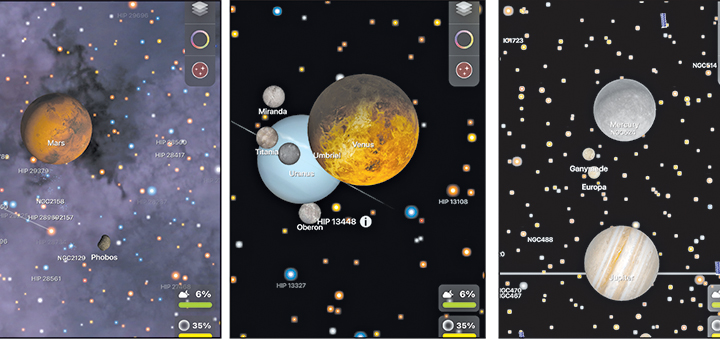Five Planets Parade In March Night Sky
Published:
March 31st, 2023
By:
Kelli Miller
 These images of a rare astronomical event and the five planets are from the NightSky app. Pictured: Mars, Uranus, Venus, Jupiter, and Mercury — align in an arc amongst the crescent moon, and can be viewed after sunset in the western skies until the end of March. (Images from NightSky)
These images of a rare astronomical event and the five planets are from the NightSky app. Pictured: Mars, Uranus, Venus, Jupiter, and Mercury — align in an arc amongst the crescent moon, and can be viewed after sunset in the western skies until the end of March. (Images from NightSky)
NORWICH — An astronomical event of planetary alignment, also called a planetary parade, is taking place in the night sky as five planets of the solar system — Jupiter, Mercury, Venus, Uranus, and Mars — will be visible until March 31. This is a rare opportunity to take a glimpse of all five planets aligning in an arc formation, including the moon.
For optimal viewing, look to the western sky just after sunset, when it’s still a little light and the sky is blue, not black.
According to information from sky.com, Mercury and Jupiter quickly disappear, approximately 30 minutes after sunset, as they are near the horizon. Mars, with its reddish glow, is next to the moon. Venus, the brightest planet known as “the evening star,” will be near Uranus, appearing as a green twinkling star above the moon. Mercury and Uranus are not as bright and will need to be viewed through a pair of binoculars or a telescope.
Planetary alignment is an astronomical term meaning where planets are situated within the same region of the sky. Another description is when planets are found within a 180 degree area of the sky. These alignments are rare, yet there will be another alignment in June with a slightly different grouping.
Sidney Central School District Earth Science Teacher Bryan Neubert said, “Covid shut down the observatory for a couple of years but fortunately we were able to open again last October for our first community observer session. We had about 50 people show up to view Jupiter and Saturn. At that time we could see Saturns’ rings perfectly. It’s always a thrill to see kids faces light up when they view the planets.”
“We try to have two viewings a year, one in the spring and one in the fall after the homecoming game. Everyone is welcome to the observer sessions. You can follow us on the school Facebook page for upcoming sessions,” Neubert added.
Former Apollo Astronaut Buzz Aldrin tweeted, “Don't forget to look to the sky [at] the end of the month for the planetary alignment which will have at least five planets, plus the moon, all visible in almost an arc shape as seen from Earth,” he wrote.
Planets do form a line, but it's not perfectly straight; All the planets orbit the Sun in almost the same plane. As a result, when viewing from Earth, the other planets appear to move along the ecliptic, or the Sun's yearly path across the sky.
Planetary alignments are distinguished by the number of participating planets involved. A mini alignment has three planets, a small alignment has four planets, and a large alignment has five or six planets. Great, or full, planetary alignments will include all solar system planets.
According to information from starwalk.space, three of the most discussed, anticipated, and noteworthy planetary alignments, which feature planets closely grouped together, are the following:
Large alignment including five planets (Mercury, Venus, Mars, Jupiter, and Saturn) can be seen with the naked eye and visible in the evening sky on March 8, 2040.
Large alignment including six planets (Venus, Mercury, Jupiter, Saturn, Mars, and Uranus) will be visible in the morning sky on March 15, 2080. This alignment will be extremely remarkable as Saturn and Jupiter will feature the “great conjunction.” A great conjunction is a conjunction of the planets Jupiter and Saturn, when the two planets appear closest together in the sky. Great conjunctions occur approximately every 20 years when Jupiter overtakes Saturn in its orbit. They are named “great” for being the rarest of conjunctions between naked-eye planets.
Great alignment includes all solar system planets, including Earth, and will be positioned on one side of the Sun, yet from Earth's view, they will appear spread out over the sky on May 19, 2161.
Fascinating celestial moments occur readily in the night sky, such as when Jupiter and Venus were within close proximity of each other this month. In April, a total solar eclipse will block the midday sun, and in October of this year a "ring of fire” eclipse can be viewed.
Catching a glimpse of astronomical phenomena can be made easier with the use of smartphone apps. Some stargazing apps available for iPhone include SkySafari, NightSky app, SkyTonight, Stellarium, Sky Guide, Light Pollution Map, and Dark Sky.
Author: Kelli Miller - More From This Author
Comments






